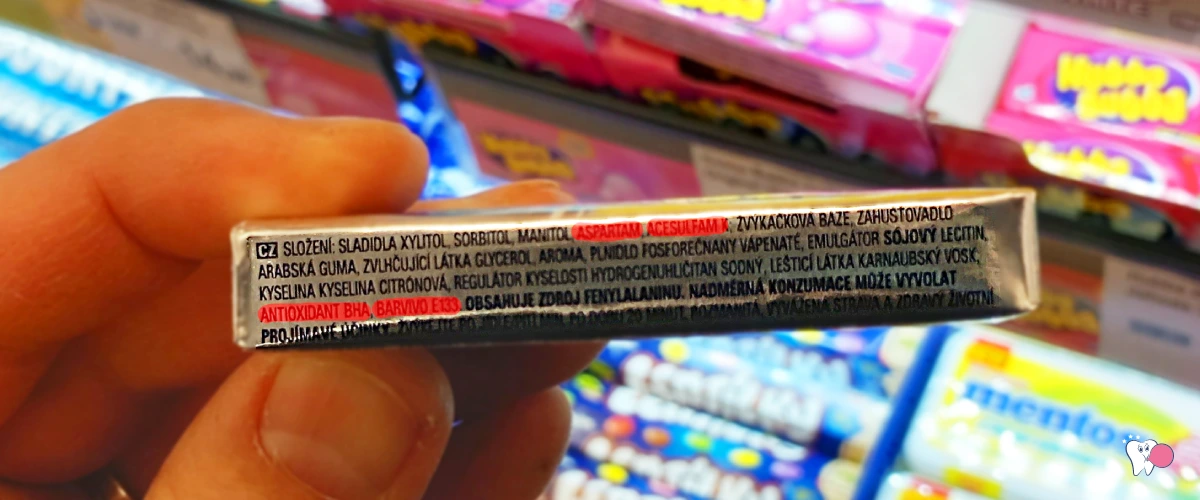Recipes for chewing gum vary between different brands, but the basic ingredients in chewing gums are similar. I advocate checking the composition of foods before purchasing, including chewing gums. Not every gum is healthy – beneficial for the body. Take a moment and decide what gums you will buy for yourself, your family, or your children.
Gum/Gum Base | Elastomers | Natural Base | Synthetic Base | Resins | Softeners | Fillers | Preservatives | Sweeteners | Flavors
Ingredients in Chewing Gums
Gum/Gum Base
Indigestible gum base is used to give the chewing gum its chewy quality, i.e., to make it chewable.
Gum base is a non-nutritive, indigestible, water-insoluble chewing system used to transport sweeteners and flavors and any other substances in chewing gums. It provides all the basic textural and chewing properties of chewing gums. The actual composition of the gum base is usually a secret of chewing gum manufacturers.
Chemicals entering the gum base are grouped into the following categories:
Elastomers (Natural/Synthetic)
They provide elasticity or bounce and can be natural latexes or synthetic rubbers. Today’s elastomers are 99% synthetic.
Natural Base (Natural Elastomers)
Old gum bases were based on either natural elastomers such as latex, plant gums like chicle, spruce gum, and mastic gum, or alternatively on waxes (e.g., paraffin, beeswax).
Synthetic Base (Synthetic Elastomers)
Until World War II, natural gum base (natural elastomer) – chicle was used. Then, a more stable chemically manufactured artificial gum base (synthetic elastomer) that replaced chicle. It is a mixture of flavored and sweetened synthetic plastics, rubbers, and waxes that are more readily available. Yes, chewing gum is largely made of plastic.
Synthetic coagulated or concentrated latexes include:
- butadiene-styrene polymers,
- vinyl acetate,
- polyethylene,
- paraffin, and
- petroleum waxes
The above are the most commonly used gum bases on the market. Synthetic elastomers are polymers derived from oil designed to maximize elasticity and incorporate into their chemical matrix other components of the gum base, as well as flavors and sweeteners. They provide elasticity or bounce.
Resins (Plasticizing Materials)
Resins is added to strengthen chewing gums and keep them together. It is part of the gum/gum base. Resins is the main chewing component. They are often esters of tree resins and rosin.
Softeners
Used to maintain moisture and prevent hardening. They can include waxes such as paraffin or plant oils.
Fillers
Used to create the texture of the gum (calcium carbonate or talc – a naturally occurring soft mineral composed of silicon, magnesium, oxygen, and hydrogen).
Preservatives (Antioxidants)
Added to extend shelf life. The most popular choices are organic compounds called butylated hydroxytoluene (BHT) and butylated hydroxyanisole (BHA). BHT works by trapping free radicals (which spoil food) and removing them.
Sweeteners
Popular sweeteners include cane sugar, beet sugar, and corn syrup. Sugar Free Chewing Gum use sugar alcohols – such as xylitol, artificial sweeteners – such as aspartame or acesulfame K.
Do you know that from July 2023, according to the WHO (World Health Organization), aspartame is among substances that are potentially carcinogenic. Before that, aspartame was never classified as a potentially carcinogenic substance. This changed in July 2023.
Flavors
Natural or synthetic flavors are added to give the gum the desired taste.
The most common flavors include:
- peppermint
- spearmint
- cinnamon
- wintergreen
- fresh fruit
- licorice
- orange
- bubble gum – pink and sweet (sometimes suitable for bubble-blowing)
- melon
Most chewing gum manufacturers keep their recipes in strict secrecy. All ingredients used in the processing of chewing gum must be listed and must meet food-grade standards for the gum to be consumable.
Generally known, chewing gums are considered safe. However, some types of chewing gum contain ingredients you should be cautious about and avoid.
You can learn about controversial additives (ingredients) to watch out for in another article on the topic:

